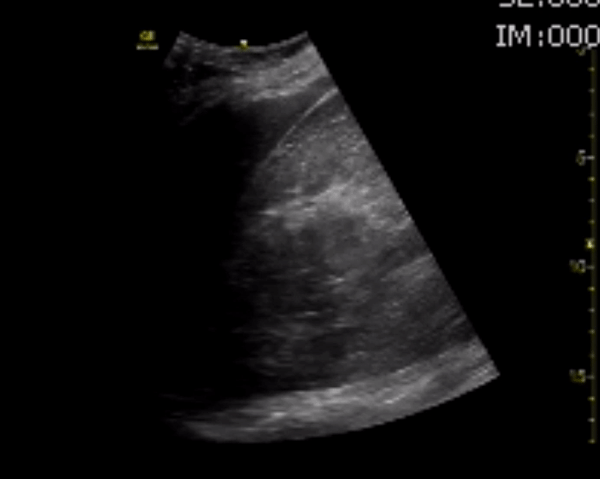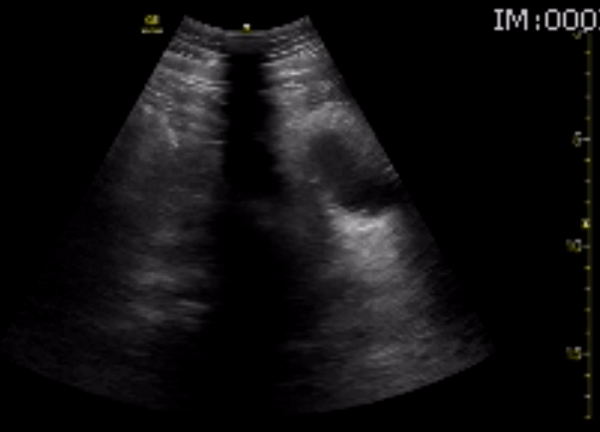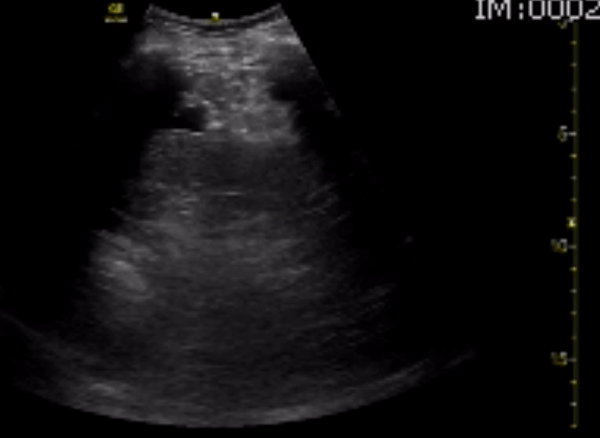An 80 year old man presents to a rural emergency room at 3am with abdominal pain. His past medical history is significant for mild hemophilia A. Six hours prior to arrival, he was driving a golf cart when he struck a pole and the steering wheel hit his stomach.
He initially had no symptoms but began to have abdominal pain while trying to sleep. He also became nauseated and vomited once. He eventually called EMS and was brought to the ER. On arrival, his vitals are as follows.
Vitals: T: 90.7, HR: 108, BP: 74/48, RR: 28, SpO2 98 on 4L
He is alert, oriented and his only complaint is abdominal pain. A FAST exam was done. What do you see? What are your next steps?



Answer and Learning Points
Answer
Although the quality of images is lacking due to the urgency of the situation and the patient's body habitus, the first image (RUQ) does not show obvious free fluid. The following images (suprapubic and LUQ) clearly show free fluid in the abdomen.
An emergent evacuation of the patient to a level 1 Trauma service was requested. Patient was transfused with two units of O blood. Due to his history of hemophilia A, the patient was also given factor VIII to 100% repletion. The patient was taken to the OR at the level 1 trauma center where he was found to have a greater omental bleed and was successfully treated with clot evacuation and laceration repair. He was placed on a factor VIII drip postop.
Learning Points
-
- Per ATLS guidelines, a hypotensive patient with a + FAST and no other signs of bleeding warrants immediate surgical exploration.
- In a 2018 meta-analysis, a positive FAST has a sensitivity of 68% and a specificity of 95%. Therefore a negative FAST does not rule out the disease, but a positive fast in the correct clinical sitting (such as this) does rule in hemoperitoneum(1).
- Hemophiliac patients require factor VIII replacement to 100% in the setting of major trauma, which is typically 50 IU/kg(2).
Author
Feigenbaum, Adam, PA-C. Emergency Medicine Fellow, Naval Medical Center San Diego.
Sukhdeep Singh, MD. Clinical Faculty, UCSD Department of Emergency Medicine. Director of POCUS, El Centro Regional Medical Center.
References
- Stengel D et al. Point-of-care ultrasonography for diagnosing thoracoabdominal injuries in patients with blunt trauma. Cochrane Database Syst Rev. 2018. Dec 12;12
- Guidelines for Emergency Department Management of Individuals with Hemophilia and Other Bleeding Disorders. https://www.hemophilia.org/Researchers-Healthcare-Providers/Medical-and-Scientific-Advisory-Council-MASAC/MASAC-Recommendations/Guidelines-for-Emergency-Department-Management-of-Individuals-with-Hemophilia-and-Other-Bleeding-Disorders. December 5, 2019

